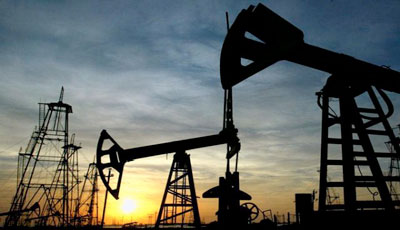Oil price projections are so enigmatic right now

Predictions range from a 20-percent reduction (to roughly $42 a barrel) to an exuberant 100-percent increase ($100) by next year. It’s enigmatic that perceptions of market experts are so enormously divergent with regard to the price of any commodity. It is doubly disconcerting given the disproportionate impact energy prices have on economies — especially economies in desperate need of fuel-injection themselves. While securing a solid grip on future oil prices is not a new dilemma, the current diversity and disparity of opinion is. It’s a situation exacerbated by President Donald Trump and the erratic, oft extreme, environment in which we find ourselves.
Unquestionably, supply and demand are paramount for determining prices. According to the Energy Information Agency, global oil production is 98.3 million barrels per day (MMPD), and consumption is a bit less at 98.1 MMPD. At that rate, the current supply glut will continue and prices should stay within a relatively tight range. That is, however, if all other things are static. Of course, they are not.
Production cuts: The Organization of the Petroleum Exporting (OPEC) and several non-OPEC nations, notably Russia, have imposed production cuts since January, reducing output by roughly 1.8 MMPD. That effort, which put supply and demand in more of an equilibrium, raised prices by a few dollars (interestingly, before actual implementation). Saudi representatives suggest the policy could continue through year’s end — a decision expected to be made on May 25th in Vienna.
Geopolitical concerns: Considerable geopolitics always plays a role in oil pricing, especially when they involve conflicts— like those in the Gulf Region, where roughly 60 percent of global oil is produced. We’ve witnessed it time and again. Things, however, are different now.
President Trump’s launch of 59 Tomahawk missiles to destroy one Syrian airstrip exacerbated an already complex situation in the Middle East, risking additional disruption of oil exports. While Syrian exports may be impacted, Syria is a small producer of only about 33,000 barrels of production per day (Poland, Peru and Papua New Guinea each produce more). More significantly, Syria is in league with Russia (the world’s largest oil producer) and Iran. Subsequent to the lifting of international sanctions on Iran, the nation is boosting production at least twofold to four, perhaps even five MMPD. Russia independently or in conjunction with allies Iran and Syria could flood global markets, thus dropping prices for not only themselves, but for those on the other side of the Syrian conflict, predominantly impacting Saudi Arabia and the US — the number two and three world oil producers, respectively.
Would Russia, Iran and Syria take such an action when it isn’t in their own economic interest? It’s difficult to determine. Consider this: U.S. and United Nation (UN) economic sanctions placed on North Korea due to their nuclear proliferation agenda has devastated the populace. The North Korean per capita income is a mere $1,800, with up to 84 percent suffering borderline or poor nutrition according to the UN. Their 33-year-old leader, Kim Jong-un, appears utterly unfazed, persistently pursuing a paranoid push for nuclear proliferation at literally all costs.
Domestic policy & politics concerns: In addition to geopolitical circumstances, there is great uncertainty about President Trump’s domestic economic agenda. While a litany of executive orders indicate an intent to roll back environmental and energy law and regulations, there’s a lack of confidence in the shelf life and reliability of many campaign policy statements. The president’s signature campaign issue was “repeal and replace Obamacare” and to date, the effort has failed. Many of us put the loss behind us in hopes the president and Congress would move on to other policy matters, igniting and energizing our economic recovery. Tax reform and infrastructure, which I’ve long argued should be done in tandem, would be the biggest boon imaginable. However, recently, the president surprised people by reversing course, stating he wants to go back and work on the Obamacare repeal and replace before other matters. And, Republicans this week began circulating a new plan. With such uncertainty, traders in financial and commodity markets are beginning to question when or if President Trump will make good on his campaign rhetoric to “Make America Great Again!”
So far, market participants generally have been on board with the president’s promises, which they hope will not only reduce regulatory burdens, but stimulate the economy. The financial sector is up 18 percent since election day, in large part accepting of that belief. Nevertheless, it’s wise to note that uncertainty also generates trading volume — whether it’s in defense or energy stocks, bonds, or commodity futures or options. Unquestionably, uncertainty is at play here as well.
The New York Mercantile Exchange (NYMEX), the preeminent oil and energy commodities trading venue, is experiencing record volumes, notably in the energy complex. The benchmark West Texas Intermediate (WTI) crude oil contract increased trading volume by 10 percent last month. On one day it reached a high of over 2.2 million contracts traded! WTI options increased an astounding 36 percent (224,000 contracts per day). Energy producers increased their positions year over year by about 40 percent. The point is that traders are speculating and hedging their risks at record levels. Healthy markets are an imperative in an increasingly unstable world. We are fortunate that our U.S. markets are, by and large, sturdy and stable.
In a world of provocations and escalating tensions, inequable price projections may well reflect the great gamut of possibilities driven by uncertainty. Familiarity with erratic leadership and geopolitics need not breed comfort. As the Australian band Midnight Oil queried, “How can we sleep while our beds are burning?” Understanding we live in troubled times helps explain the dramatic discrepancies in price projections.
Source: Hellenic Shipping News




























